Developing the Recovery Gap Index: A Comprehensive Tool for Assessing National Disaster Recovery Capacities
Abstract
1. Introduction
2. Existing Indices for Risk Assessment and Management
2.1. INFORM Index
- Hazard and exposure: This dimension evaluates the probability and impact of various natural and human-made hazards, including earthquakes, floods, tropical cyclones, droughts, epidemics, and conflicts. Using historical data, the INFORM Index assesses the frequency, intensity, and distribution of these events over time, providing a clear picture of the baseline risks faced by populations and infrastructure. This approach helps identify regions that are recurrently affected and more vulnerable, supporting more effective risk management and mitigation strategies.
- Vulnerability: This dimension assesses socioeconomic factors that affect a population’s susceptibility. It includes indicators such as poverty rates, access to healthcare, literacy rates, malnutrition, and population density. These factors help in evaluating how different communities might be differentially impacted by the same hazard, providing insights into the underlying vulnerabilities that exacerbate the impacts of disasters.
- Lack of coping capacity: This dimension examines the ability of governance structures and infrastructure to manage and mitigate the effects of disasters. It includes indicators like governance effectiveness, infrastructure quality, emergency response capabilities, and logistical capacity. This dimension evaluates the readiness and resilience of a region to respond to and recover from disasters.
2.2. World Risk Index
- Exposure: This component measures the likelihood of a region being affected by natural hazards such as earthquakes, storms, floods, and sea-level rise. It uses historical data to evaluate the frequency, severity, and geographical spread of these hazards over time. Indicators include the number of recorded events and their intensity, giving a clear picture of the areas most frequently impacted. This historical approach helps to understand not only current risk levels but also the potential for future events.
- Susceptibility This component evaluates conditions that increase the likelihood of suffering harm from a hazard. Indicators include economic status, food security, public infrastructure, housing conditions, and the prevalence of diseases. Susceptibility reflects the intrinsic vulnerability of a society to various hazards and provides insights into the potential impacts on human health and well-being.
- Coping capacities: This component assesses the ability of societies to respond effectively to disasters. It includes governance quality, disaster preparedness, healthcare systems, and access to clean water and sanitation. Coping capacities measure the immediate response potential of a society when a disaster strikes, highlighting strengths and weaknesses in disaster management infrastructure.
- Adaptive capacities: This component focuses on long-term strategies to mitigate future risks. Indicators include education levels, investment in research, sustainable development initiatives, and environmental protection measures. Adaptive capacities evaluate a society’s ability to adapt and transform in the face of evolving risk landscapes, emphasizing the importance of resilience and sustainability in disaster risk reduction.
2.3. GIRI
- Capacity to absorb: This dimension measures the robustness of existing infrastructure and sociodemographic factors affecting resilience. Indicators include the quality of buildings, roads, and other critical infrastructure, as well as population distribution and density. These factors determine how well a region can withstand the initial impact of a disaster. The index also considers historical data on infrastructure performance during past disasters to enhance the predictive accuracy of the model.
- Capacity to respond: This dimension evaluates the availability and effectiveness of emergency services, governance structures, and technological resources. Indicators include the presence of emergency response teams, communication systems, and comprehensive disaster management plans. These elements are crucial for an immediate and effective response to disasters. The index assesses the integration of advanced technologies such as early warning systems and remote sensing in disaster response strategies.
- Capacity to recover: This dimension assesses long-term recovery potential by examining economic stability, investment in infrastructure, and social support systems. Indicators include GDP per capita, investment levels in public infrastructure, social capital, and access to financial resources for reconstruction. These factors influence how quickly and effectively a region can rebuild and recover following a disaster. The index incorporates scenario analysis to evaluate the impact of different recovery strategies and investment priorities on long-term resilience.
2.4. Limitations of Existing Indices and Need for the Recovery Gap Index
3. Materials and Methods
3.1. Data Collection and Integration
3.2. Definition of Categories and Subcategories
- Sociodemographic: This category evaluates factors such as population density, literacy rates, and healthcare access, which influence the ability of populations to recover effectively [53].
- Infrastructure and resources: This category examines the quality and availability of essential services, such as emergency response capabilities and access to clean water, which are vital during recovery efforts [48].
- Government and policy: This category assesses governance effectiveness, the presence of disaster preparedness plans, and the ability of political frameworks to support recovery operations [27].
- Technological: This category addresses the use of advanced technologies, such as early warning systems and remote sensing, which play a crucial role in facilitating recovery processes [54].
- Economic: This category captures financial aspects, including GDP per capita and public investments, which significantly affect recovery speed and sustainability [55].
3.3. Index Calculation and Development Process
4. Results and Discussion
4.1. Global and Regional RGI Results
4.2. Global and Regional Recovery Disparities
4.3. Country-Specific Insights
4.4. RGI Limitations
- Data availability and quality: The RGI relies on publicly available datasets, including the INFORM Index, GIRI, and World Risk Index. While these datasets are well established and widely used, their coverage and granularity can vary significantly, particularly for less developed regions. For example, some indicators may not be updated regularly, or data for specific countries may be incomplete. In some cases, missing or outdated data may affect the accuracy of the results, highlighting the need for more localized and up-to-date datasets in future iterations of the RGI. Future iterations of the RGI should aim to incorporate more localized, high-resolution, and up-to-date datasets, particularly for underrepresented regions, to improve accuracy and inclusivity. Collaboration with national statistical agencies and international organizations could facilitate this process.
- Equal weighting of categories: The current RGI assigns equal weight to all five main categories (sociodemographic, infrastructure and resources, government and policy, technological, and economic). This approach, while neutral and straightforward, may not reflect the varying importance of these dimensions in different national or regional contexts. For instance, governance may play a more critical role in some countries, while infrastructure could be the limiting factor in others. Future research could address this limitation by exploring context-specific weighting schemes derived from empirical data or expert consultation.
- National-level focus: The RGI is designed for national-level assessments, which may overlook significant sub-national variations in recovery capacity. For instance, disparities between urban and rural areas or among administrative regions within a country can be substantial. Including regional or local data in future iterations of the RGI would provide a more nuanced understanding of recovery dynamics.
- Limited consideration of cascading and multi-hazard effects: While the RGI accounts for recovery capacities following individual or consecutive extreme events, it does not explicitly model cascading hazards or their long-term socioeconomic impacts. For example, the compounding effects of back-to-back disasters, such as a flood followed by an epidemic, may not be fully captured. Future work could integrate dynamic modeling approaches to address these interactions.
- Simplification of recovery dynamics: The RGI simplifies the complexity of recovery by aggregating indicators into categories and using a composite index. While this approach provides a clear and comparable metric, it may not capture the full range of factors influencing recovery, such as social cohesion or cultural dimensions. These aspects could be explored in future research to provide a more holistic understanding.
- Theoretical and empirical validation: While the RGI is based on a robust theoretical framework and uses data from established indices, its empirical validation remains a priority for future work. Testing the RGI against real-world recovery scenarios through case studies or historical data could strengthen its reliability and practical applicability. Additionally, feedback from disaster management practitioners could provide valuable insights for refining the methodology and improving its operational relevance.
5. Conclusions and Future Directions
5.1. Summary of Key Findings
5.2. Future Research Directions
- Integration of early warning systems (EWSs): Incorporating data on early warning systems (EWS), as highlighted by the United Nations’ “Early Warnings for All” initiative [69], could significantly enhance the RGI’s ability to evaluate a country’s preparedness. EWS are crucial for mitigating the impacts of disasters by enabling timely evacuations and preparation measures. Using sources like the Sendai Framework Monitor, which provides global information on multi-hazard early warning systems [70], would add a valuable dimension to the RGI. However, this integration would require the normalization of new indicators to align them with the existing framework [71,72].
- Inclusion of insurance coverage metrics: Integrating metrics related to insurance coverage, such as the Natural Catastrophe Insurance Resilience Index (I-RI) and the Natural Catastrophe Protection Gap, would provide deeper insights into a nation’s financial resilience and its capacity to recover from economic shocks caused by disasters [55,73,74,75]. These metrics highlight the disparity between available and necessary insurance coverage, revealing financial vulnerabilities that are critical for a comprehensive assessment of national recovery capabilities.
- Evaluation of legal and policy frameworks: Assessing the robustness of disaster response laws and emergency plans is essential, as studies indicate that well-established legal frameworks can significantly improve the efficiency of post-event recovery [76]. Developing a comprehensive database of national disaster response policies would offer valuable insights into governance and institutional readiness. Although this would involve extensive data collection and country-specific research, it would greatly enhance the RGI’s ability to evaluate legal and organizational capacities.
- Refinement of weighting and normalization methods: The current RGI assigns equal weight to all components, which may not accurately reflect their relative importance across different contexts. Future iterations could refine this approach by adjusting the weights based on empirical data from detailed case studies, offering a more accurate and context-specific assessment [56]. This would require collaboration with national authorities and disaster management experts to ensure that the revised weights are relevant and reflect real-world recovery dynamics.
- Developing targeted recommendations based on RGI categories: The RGI, with its detailed categorization of recovery capacities across dimensions such as government and policy, infrastructure and resources, technological capacity, sociodemographic, and economic factors, provides a valuable tool for identifying specific areas of improvement for each country. The availability of category-specific scores for every nation allows for the development of tailored recommendations that address the unique challenges highlighted by the RGI. For instance, a country with a high score in government and policy might prioritize improving institutional coordination and transparency to strengthen its governance systems, while a nation with elevated technological scores could focus on enhancing early warning systems or training personnel to better utilize disaster management tools. Similarly, regions with high sociodemographic scores could invest in public awareness campaigns and equitable access to healthcare, and those with economic vulnerabilities may seek to diversify revenue streams or implement social safety nets. Future research could expand on these initial insights by exploring how the RGI can be used to generate detailed, country-specific recommendations, providing actionable guidance for policymakers and stakeholders.
- Using the RGI for risk and timeline assessments: The RGI provides a robust measure of national recovery and response capacities, but future research could expand its application by integrating it with parameters such as hazard intensity, exposure characteristics, and vulnerability metrics. This combination would enable predictive models for estimating recovery and response timelines, offering policymakers actionable insights for prioritizing interventions. For instance, regions with high RGI scores could be identified for capacity-building efforts, while areas with lower scores but significant exposure might require immediate focus. Such integrative approaches would support more dynamic and comprehensive frameworks for disaster risk management and resilience planning.
Supplementary Materials
Author Contributions
Funding
Institutional Review Board Statement
Informed Consent Statement
Data Availability Statement
Conflicts of Interest
Appendix A
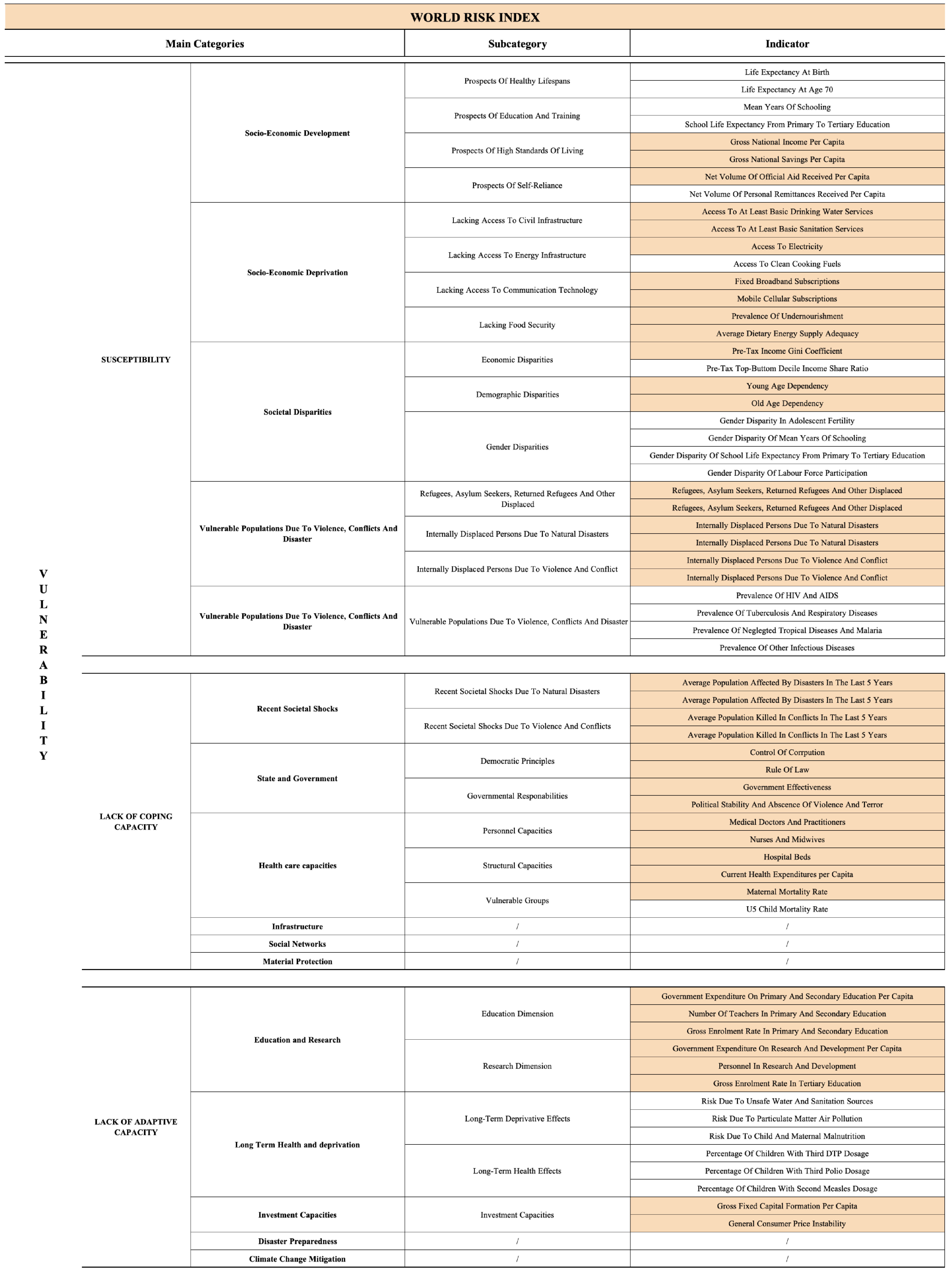
Appendix B

Appendix C
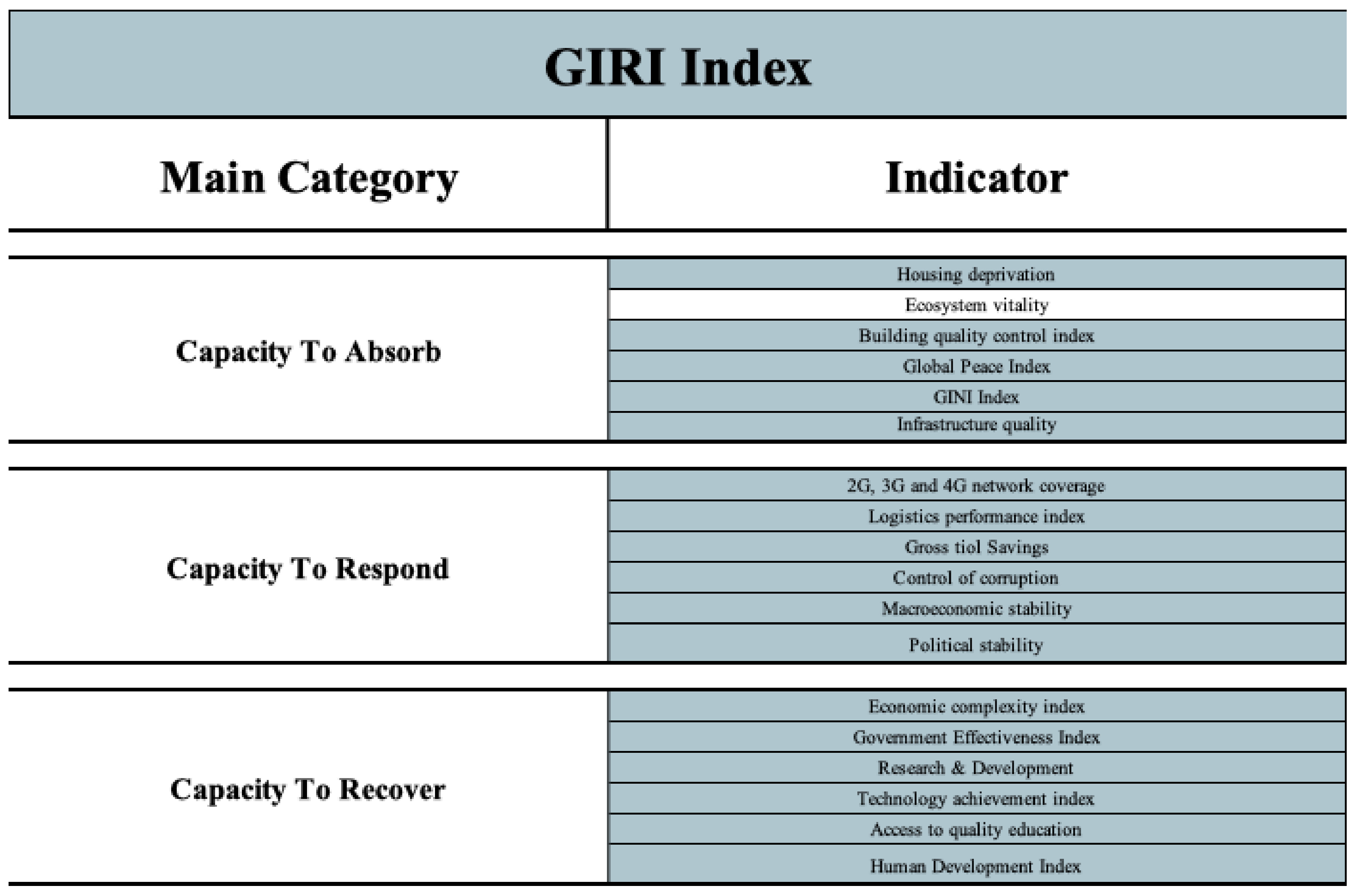
Appendix D
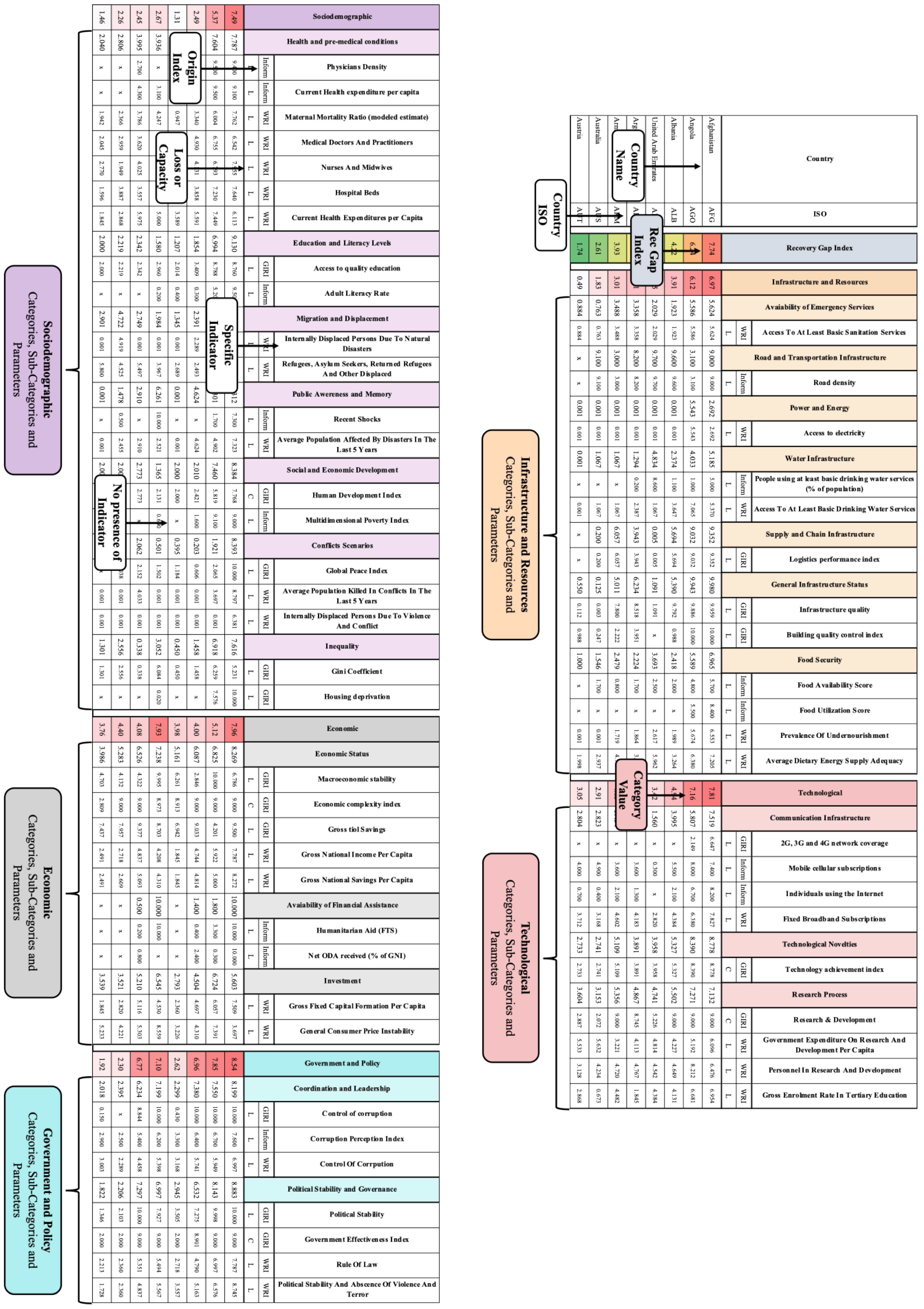
References
- CRED. Annual Disaster Statistical Review 2022: The Numbers and Trends; Centre for Research on the Epidemiology of Disasters (CRED), Université catholique de Louvain: Ottignies-Louvain-la-Neuve, Belgium, 2023. [Google Scholar]
- IPCC. Climate Change 2021: The Physical Science Basis. Contribution of Working Group I to the Sixth Assessment Report of the Intergovernmental Panel on Climate Change; Cambridge University Press: Cambridge, UK, 2021. [Google Scholar]
- UNDRR. Human Cost of Disasters: An Overview of the Last 20 Years 2000–2019; United Nations Office for Disaster Risk Reduction: Geneva, Switzerland, 2020. [Google Scholar]
- Clarke, B.; Otto, F.; Stuart-Smith, R. Extreme Weather Impacts of Climate Change: An Attribution Perspective. Environ. Res. Clim. 2022, 1, 012001. [Google Scholar] [CrossRef]
- Emanuel, K. Downscaling CMIP5 Climate Models Shows Increased Tropical Cyclone Activity Over the 21st Century. Proc. Natl. Acad. Sci. USA 2013, 110, 12219–12224. [Google Scholar] [CrossRef] [PubMed]
- Trenberth, K.E.; Cheng, L.; Jacobs, P.; Zhang, Y.; Fasullo, J. Hurricane Harvey Links to Ocean Heat Content and Climate Change Adaptation. Earth’s Future 2018, 6, 730–744. [Google Scholar] [CrossRef]
- Li, H.; Xu, E.; Zhang, H. Examining the Coupling Relationship Between Urbanization and Natural Disasters: A Case Study of the Pearl River Delta, China. Int. J. Disaster Risk Reduct. 2021, 58, 102373. [Google Scholar] [CrossRef]
- Botzen, W.J.W.; Deschenes, O.; Sanders, M. The Economic Impacts of Natural Disasters: A Review of Models and Empirical Studies. Rev. Environ. Econ. Policy 2019, 13, 167–188. [Google Scholar] [CrossRef]
- Wahlstrom, M.; Guha-Sapir, D. The Human Cost of Weather Related Disasters 1995–2015; UNISDR: Geneva, Switzerland, 2015. [Google Scholar]
- Ward, P.J.; de Ruiter, M.C.; Daniell, J.E.; Blauhut, V.; Bloemendaal, N.; Veldkamp, T.I.E. Bending the Trend: Towards Sustainable Flood and Drought Risk Solutions Through Understanding Global Disaster Risk. Environ. Res. Lett. 2020, 15, 113005. [Google Scholar]
- Kunreuther, H.; Michel-Kerjan, E.; Doherty, N.; Grace, M.; Klein, R.; Pauly, M. At War with the Weather: Managing Large-Scale Risks in a New Era of Catastrophes; MIT Press: Cambridge, MA, USA, 2013. [Google Scholar]
- Mori, N.; Takahashi, T.; Yasuda, T.; Yanagisawa, H. Survey of 2011 Tohoku Earthquake Tsunami Inundation and Run-Up. Geophys. Res. Lett. 2013, 38, L00G14. [Google Scholar]
- Kishore, N.; Marqués, D.; Mahmud, A.; Kiang, M.V.; Rodriguez, I.; Fuller, A.; Leaning, J. Mortality in Puerto Rico After Hurricane Maria. N. Engl. J. Med. 2018, 379, 162–170. [Google Scholar] [CrossRef]
- Ward, P.J.; Blauhut, V.; Bloemendaal, N.; Daniell, J.E.; de Ruiter, M.C.; Duncan, M.J.; Emberson, R.; Jenkins, S.F.; Kirschbaum, D.; Kunz, M. Natural Hazard Risk Assessments at the Global Scale. Nat. Hazards Earth Syst. Sci. 2020, 20, 1069–1082. [Google Scholar] [CrossRef]
- Ridder, N.N.; Pitman, A.J.; Westra, S.; Ukkola, A.M.; Do, H.X.; Bador, M.; Hirsch, A.L.; Evans, J.P.; Di Luca, A.; Zscheischler, J. Global Hotspots for the Occurrence of Compound Events. Nat. Commun. 2020, 11, 5956. [Google Scholar] [CrossRef]
- Gall, M.; Borden, K.A.; Cutter, S.L. When Do Losses Count? Six Fallacies of Natural Hazards Loss Data. Bull. Am. Meteorol. Soc. 2014, 90, 799–809. [Google Scholar] [CrossRef]
- de Ruiter, M.C.; Van Loon, A.F. The Challenges of Dynamic Vulnerability and How to Assess It. iScience 2022, 25, 105592. [Google Scholar] [CrossRef] [PubMed]
- Zscheischler, J.; Martius, O.; Westra, S.; Bevacqua, E.; Raymond, C.; Horton, R.M.; van den Hurk, B.; AghaKouchak, A.; Jézéquel, A.; Mahecha, M.D.; et al. A Typology of Compound Weather and Climate Events. Nat. Rev. Earth Environ. 2020, 1, 333–347. [Google Scholar] [CrossRef]
- Raymond, C.; Horton, R.M.; Zscheischler, J.; Martius, O.; AghaKouchak, A.; Balch, J.; Bowen, S.G.; Camargo, S.J.; Hess, J.; Kornhuber, K.; et al. Understanding and Managing Connected Extreme Events. Nat. Clim. Change 2020, 10, 611–621. [Google Scholar] [CrossRef]
- De Angeli, S.; Borre, A.; Trasforini, E.; Ottonelli, D.; Boni, G.; Ghizzoni, T. A mathematical framework to quantify physical damages from concurrent and consecutive hazards. In Proceedings of the EGU General Assembly 2024, Vienna, Austria, 14–19 April 2024. EGU24-9418. [Google Scholar] [CrossRef]
- Folke, C. Resilience: The emergence of a perspective for social–ecological systems analyses. Glob. Environ. Change 2006, 16, 253–267. [Google Scholar] [CrossRef]
- Cutter, S.L.; Barnes, L.; Berry, M.; Burton, C.; Evans, E.; Tate, E.; Webb, J. A place-based model for understanding community resilience to natural disasters. Glob. Environ. Change 2008, 18, 598–606. [Google Scholar] [CrossRef]
- Gill, J.C.; Malamud, B.D. Reviewing and Visualizing the Interactions of Natural Hazards. Rev. Geophys. 2014, 52, 680–722. [Google Scholar] [CrossRef]
- Trogrlić, R.Š.; Duncan, M.J.; Wright, G.B.; Adeloye, A.J.; Mwale, F.D. Multi-Hazard Early Warning Systems: A Case Study of Malawi. Int. J. Disaster Risk Reduct. 2024, 85, 103075. [Google Scholar]
- Tierney, K. The Social Roots of Risk: Producing Disasters, Promoting Resilience; Stanford University Press: Stanford, CA, USA, 2014. [Google Scholar]
- De Groeve, T.; Poljansek, K.; Vernaccini, L.; Ispra, J.R.C. Index for Risk Management (INFORM) Concept and Methodology Report; European Commission: Luxembourg, 2014. [Google Scholar]
- GFDRR. GIRI Is the First Fully Probabilistic Model to Identify and Estimate the Risk Associated with Major Hazards; Global Facility for Disaster Reduction and Recovery: Washington, DC, USA, 2023. [Google Scholar]
- Manyena, B.; Machingura, F.; O’Keefe, P. Disaster Resilience Integrated Framework for Transformation (DRIFT): A new approach to theorising and operationalising resilience. World Dev. 2019, 123, 104587. [Google Scholar] [CrossRef]
- Birkmann, J.; Welle, T.; Krause, D.; Wolfertz, J.; Suarez, D.-C.; Setiadi, N. World Risk Index: Concept and Results. In World Risk Report 2011; Bündnis Entwicklung Hilft: Berlin, Germany, 2011. [Google Scholar]
- Birkmann, J.; Cardona, O.D.; Carreño, M.L.; Barbat, A.H.; Pelling, M.; Schneiderbauer, S.; Welle, T. Framing Vulnerability, Risk and Societal Responses: The MOVE Framework. Nat. Hazards 2013, 67, 193–211. [Google Scholar] [CrossRef]
- Panwar, V.; Sen, S. Economic Impact of Natural Disasters: An Empirical Re-Examination. Margin J. Appl. Econ. Res. 2019, 13, 217–241. [Google Scholar] [CrossRef]
- Nofal, O.M.; Amini, K.; Padgett, J.E.; van de Lindt, J.W.; Rosenheim, N.; Darestani, Y.M.; Enderami, A.; Sutley, E.J.; Hamideh, S.; Duenas-Osorio, L. Multi-Hazard Socio-Physical Resilience Assessment of Hurricane-Induced Hazards on Coastal Communities. Resilient Cities Struct. 2023, 2, 67–81. [Google Scholar] [CrossRef]
- Hofmann, R. Resilience to Extreme Natural Events: Concepts, Measures, and Policies. In Natural Hazards: Impacts, Adjustments, and Resilience; Springer: Cham, Switzerland, 2021. [Google Scholar]
- Khan, M.T.I.; Anwar, S.; Sarkodie, S.A. Do Natural Disasters Affect Economic Growth? The Role of Human Capital, Foreign Direct Investment, and Infrastructure Dynamics. Heliyon 2023, 9, e01118. [Google Scholar] [CrossRef] [PubMed]
- Marin-Ferrer, M.; Vernaccini, L.; Poljansek, K. Index for Risk Management INFORM Concept and Methodology Report—Version 2017; European Commission: Luxembourg, 2017. [Google Scholar] [CrossRef]
- INFORM Index. INFORM Report 2023: Shared Evidence for Managing Crises and Disasters; Publication Office of the European Union: Luxembourg, 2023. [Google Scholar]
- Peduzzi, P.; Dao, H.; Herold, C.; Mouton, F. Assessing Global Exposure and Vulnerability Towards Natural Hazards: The Disaster Risk Index. Nat. Hazards Earth Syst. Sci. 2009, 9, 1149–1159. [Google Scholar] [CrossRef]
- Haque, D.M.E.; Mimi, A.; Mazumder, R.K. Evaluation of Natural Hazard Risk for Coastal Districts of Bangladesh Using the INFORM Approach. Int. J. Disaster Risk Reduct. 2020, 46, 101517. [Google Scholar] [CrossRef]
- INFORM. INFORM Annual Report 2024; European Commission: Luxembourg, 2024. [Google Scholar]
- Visser, H.; De Bruin, S.; Martens, A.; Knoop, J. What Users of Global Risk Indicators Should Know. Glob. Environ. Change 2020, 63, 102120. [Google Scholar] [CrossRef]
- Birkmann, J.; Cutter, S.L.; Rothman, D.S.; Welle, T.; Garschagen, M.; van Ruijven, B.; Setiadi, N. Scenarios for Vulnerability: Opportunities and Constraints in the Context of Climate Change and Disaster Risk. Clim. Change 2022, 133, 53–68. [Google Scholar] [CrossRef]
- Depietri, Y. The Social–Ecological Dimension of Vulnerability and Risk to Natural Hazards. Sustain. Sci. 2020, 15, 1001–1015. [Google Scholar] [CrossRef]
- Garschagen, M.; Doshi, D.; Reith, J.; Hagenlocher, M. Global Patterns of Disaster and Climate Risk—An Analysis of the Consistency of Leading Index-Based Assessments and Their Results. Clim. Change 2021, 167, 11. [Google Scholar] [CrossRef]
- Ramli, M.W.A.; Alias, N.E.B.; Yusop, Z. Disaster Risk Index: A Review of Local Scale Concept and Methodologies. IOP Conf. Ser. Earth Environ. Sci. 2020, 479, 012023. [Google Scholar] [CrossRef]
- UNU-EHS Official Website—World Risk Report 2022. Available online: https://www.worldriskreport.org (accessed on 2 September 2024).
- GFDRR. The Making of a Riskier Future: How Our Decisions Are Shaping Future Disaster Risk; Global Facility for Disaster Reduction and Recovery: Washington, DC, USA, 2016. [Google Scholar]
- UNESCAP. Multi-Hazard Risk to Exposed Stock and Critical Infrastructure in Central Asia: A Probabilistic Risk Assessment Approach Using the GIRI Model. Available online: https://repository.unescap.org/bitstream/handle/20.500.12870/4109/ESCAP-2020-WP-Multi-Hazard-Risk.pdf?sequence=1&isAllowed=y (accessed on 2 September 2024).
- Dhakal, S.; Zhang, L. A Social Welfare–Based Infrastructure Resilience Assessment Framework: Toward Equitable Resilience for Infrastructure Development. Nat. Hazards Rev. 2023, 24, 04022043. [Google Scholar] [CrossRef]
- Shiozaki, Y.; Nagamatsu, S.; Sato, K.; Bhattacharya, Y. A Systematic Literature Review of Empirical Validation of Disaster Resilience Indicators. Int. J. Disaster Risk Reduct. 2024, 111, 104681. [Google Scholar] [CrossRef]
- Rodriquez, C.; Mendes, J.M.; Romão, X. Identifying the Importance of Disaster Resilience Dimensions Across Different Countries Using the Delphi Method. Sustainability 2022, 14, 9162. [Google Scholar] [CrossRef]
- Burton, C.G.; Asad, K.M.B.; Musori, M. The Validation and Development of Composite Indices for Measuring Vulnerability and Recovery Potential from Earthquakes; Global Earthquake Model Foundation: Pavia, Italy, 2019. [Google Scholar]
- Saja, A.M.A.; Goonetilleke, A.; Teo, M.; Ziyath, A.M. A critical review of social resilience assessment frameworks in disaster management. Int. J. Disaster Risk Reduct. 2019, 35, 101096. [Google Scholar] [CrossRef]
- Cutter, S.L.; Boruff, B.J.; Shirley, W.L. Social Vulnerability to Environmental Hazards. In Hazards, Vulnerability and Environmental Justice, 2nd ed.; Routledge: London, UK, 2008; pp. 115–132. [Google Scholar]
- Hallegatte, S.; Rentschler, J.; Rozenberg, J. Lifelines: The Resilient Infrastructure Opportunity; World Bank: Washington, DC, USA, 2019. [Google Scholar]
- World Bank. The Role of Insurance in Disaster Risk Reduction; World Bank: Washington, DC, USA, 2023. [Google Scholar]
- OECD. Handbook on Constructing Composite Indicators; OECD: Paris, France, 2008. [Google Scholar]
- Saltelli, A.; Tarantola, S.; Campolongo, F.; Ratto, M. Sensitivity Analysis in Practice: A Guide to Assessing Scientific Models; John Wiley & Sons Inc.: Hoboken, NJ, USA, 2004. [Google Scholar]
- Greco, S.; Ishizaka, A.; Tasiou, M.; Torrisi, G. On the Methodological Framework of Composite Indices: A Review of the Issues of Weighting, Aggregation, and Robustness. Soc. Indic. Res. 2019, 141, 61–94. [Google Scholar] [CrossRef]
- Jongman, B.; Ward, P.J.; Aerts, J.C. Global Exposure to River and Coastal Flooding: Long-Term Trends and Changes. Glob. Environ. Change 2015, 31, 1–12. [Google Scholar] [CrossRef]
- Thieken, A.H.; Petrow, T.; Kreibich, H.; Merz, B. Insurability and Mitigation of Flood Losses in Private Households in Germany. Risk Anal. 2016, 26, 383–395. [Google Scholar] [CrossRef]
- Shi, P.; Kasperson, R.; Jia, H. World Atlas of Natural Disaster Risk; Springer: Cham, Switzerland, 2020. [Google Scholar]
- Kelman, I.; Gaillard, J.C.; Mercer, J. Climate Change’s Role in Disaster Risk Reduction’s Future: Beyond Vulnerability and Resilience. Int. J. Disaster Risk Sci. 2022, 13, 1–10. [Google Scholar] [CrossRef]
- Lopez-Carr, D.; Marter-Kenyon, J.; Pricope, N. A Spatial Analysis of Climate-Related Disaster Resilience Across the Globe. Environ. Res. Lett. 2022, 17, 024017. [Google Scholar]
- Balk, D.; Montgomery, M.R.; Todd, M. Urbanization and Vulnerability to Climate-Related Disasters in Europe and the Americas. Environ. Res. Lett. 2021, 16, 045008. [Google Scholar]
- Cutter, S.L.; Emrich, C.T.; Mitchell, J.T. Disaster Resilience Indicators for Benchmarking Baseline Conditions. J. Homel. Secur. Emerg. Manag. 2015, 12, 585–602. [Google Scholar] [CrossRef]
- Neumayer, E.; Plümper, T. The Gendered Nature of Natural Disasters: The Impact of Catastrophic Events on the Gender Gap in Life Expectancy, 1981–2002. Ann. Assoc. Am. Geogr. 2017, 97, 551–566. [Google Scholar] [CrossRef]
- Boin, A.; McConnell, A.; ’t Hart, P. Governing the Pandemic: The Politics of Navigating a Mega-Crisis; Palgrave Macmillan: London, UK, 2020. [Google Scholar]
- Fuchs, S.; Kuhlicke, C.; Meyer, V. Editorial for the Special Issue: Vulnerability and Resilience to Natural Hazards–Theory and Practical Application. Nat. Hazards 2021, 101, 1–9. [Google Scholar]
- United Nations. Early Warnings for All Initiative; United Nations: New York, NY, USA, 2023; Available online: https://www.un.org/en/climatechange/early-warnings-for-all (accessed on 2 September 2024).
- Sendai Framework Monitor. Target G: Global Status of Multi-Hazard Early Warning Systems; Sendai Framework Monitor: Geneva, Switzerland, 2022. [Google Scholar]
- Basher, R. Global Early Warning Systems for Natural Hazards: Systematic and People-Centred. Philos. Trans. R. Soc. A Math. Phys. Eng. Sci. 2006, 364, 2167–2182. [Google Scholar] [CrossRef]
- Cools, J.; Innocenti, D.; O’Brien, S. Lessons from Flood Early Warning Systems. Environ. Sci. Policy 2016, 58, 117–122. [Google Scholar] [CrossRef]
- Swiss Re Institute. Restoring Resilience: The Need to Reload Shock Absorbing Capacity; Sigma Report; Swiss Re: Zurich, Switzerland, 2022; Available online: https://www.swissre.com/institute/research/sigma-research/sigma-2022-03.html (accessed on 2 September 2024).
- European Insurance and Occupational Pensions Authority (EIOPA). Natural Catastrophe Dashboard; EIOPA: Frankfurt, Germany, 2023; Available online: https://www.eiopa.europa.eu/tools-and-data/dashboard-insurance-protection-gap-natural-catastrophes_en (accessed on 2 September 2024).
- Surminski, S.; Oramas-Dorta, D. Flood Insurance Schemes and Climate Adaptation in Developing Countries. Int. J. Disaster Risk Reduct. 2014, 7, 154–164. [Google Scholar] [CrossRef]
- Birkmann, J.; Welle, T. Enhancing Disaster Resilience Through Legal and Policy Frameworks: Insights from the World Risk Index. J. Extreme Events 2022. [Google Scholar]
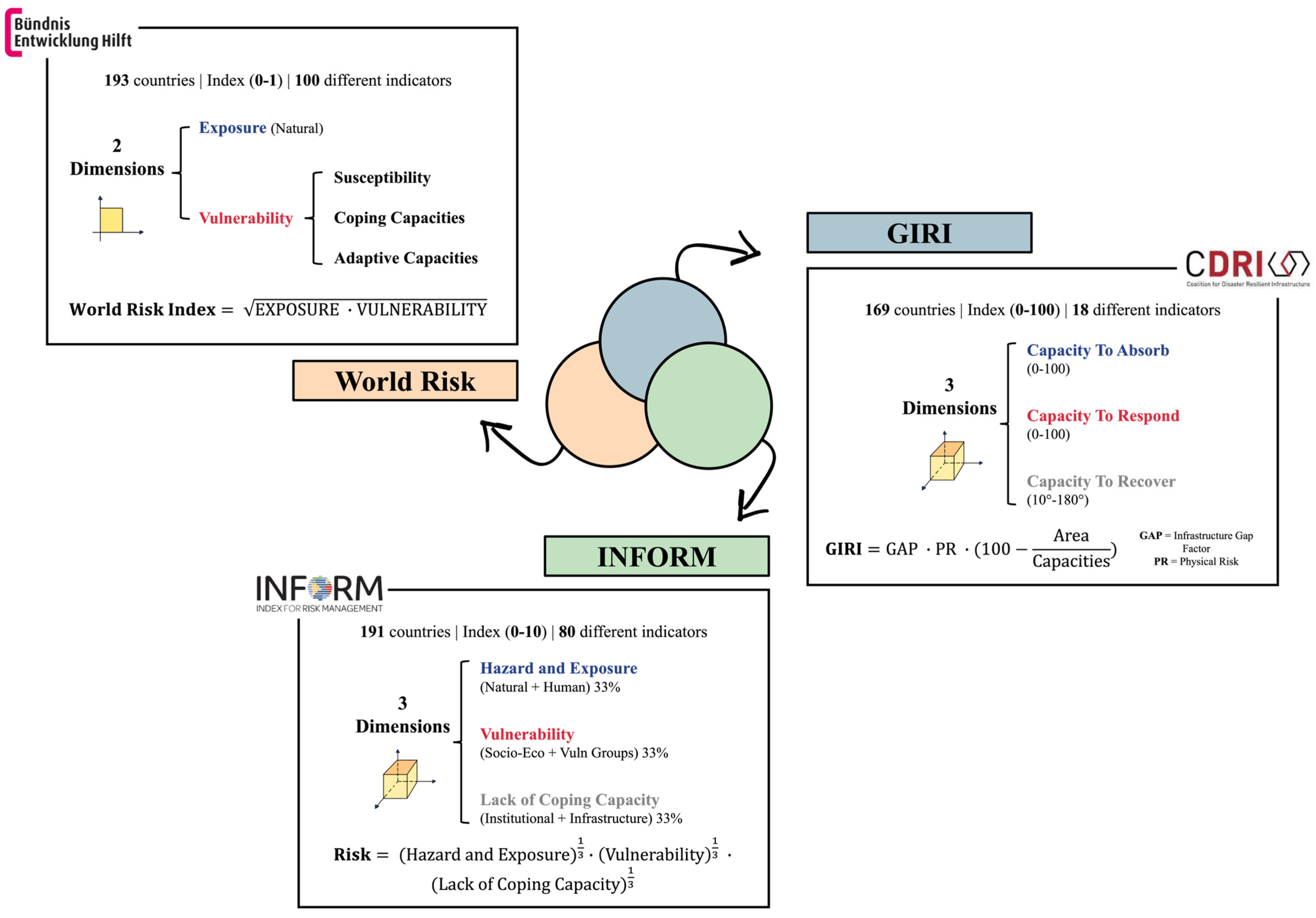
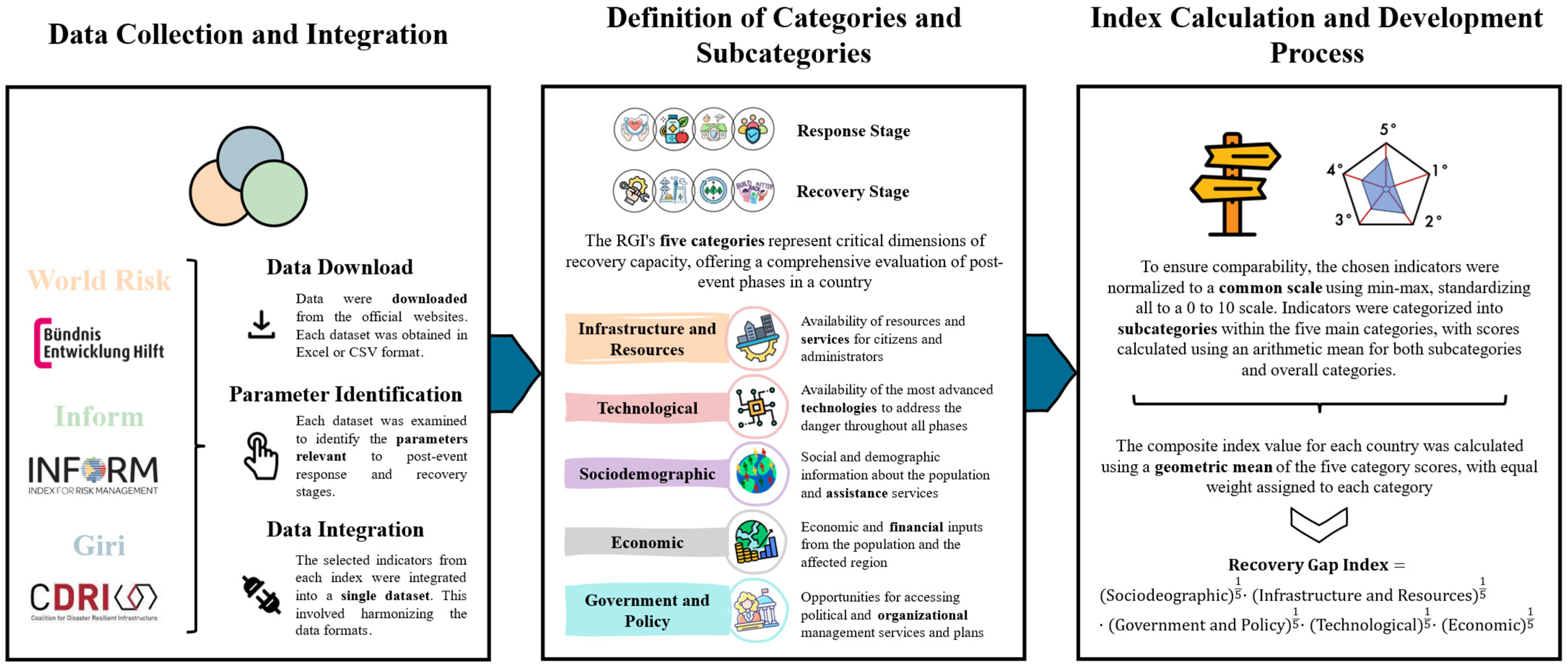
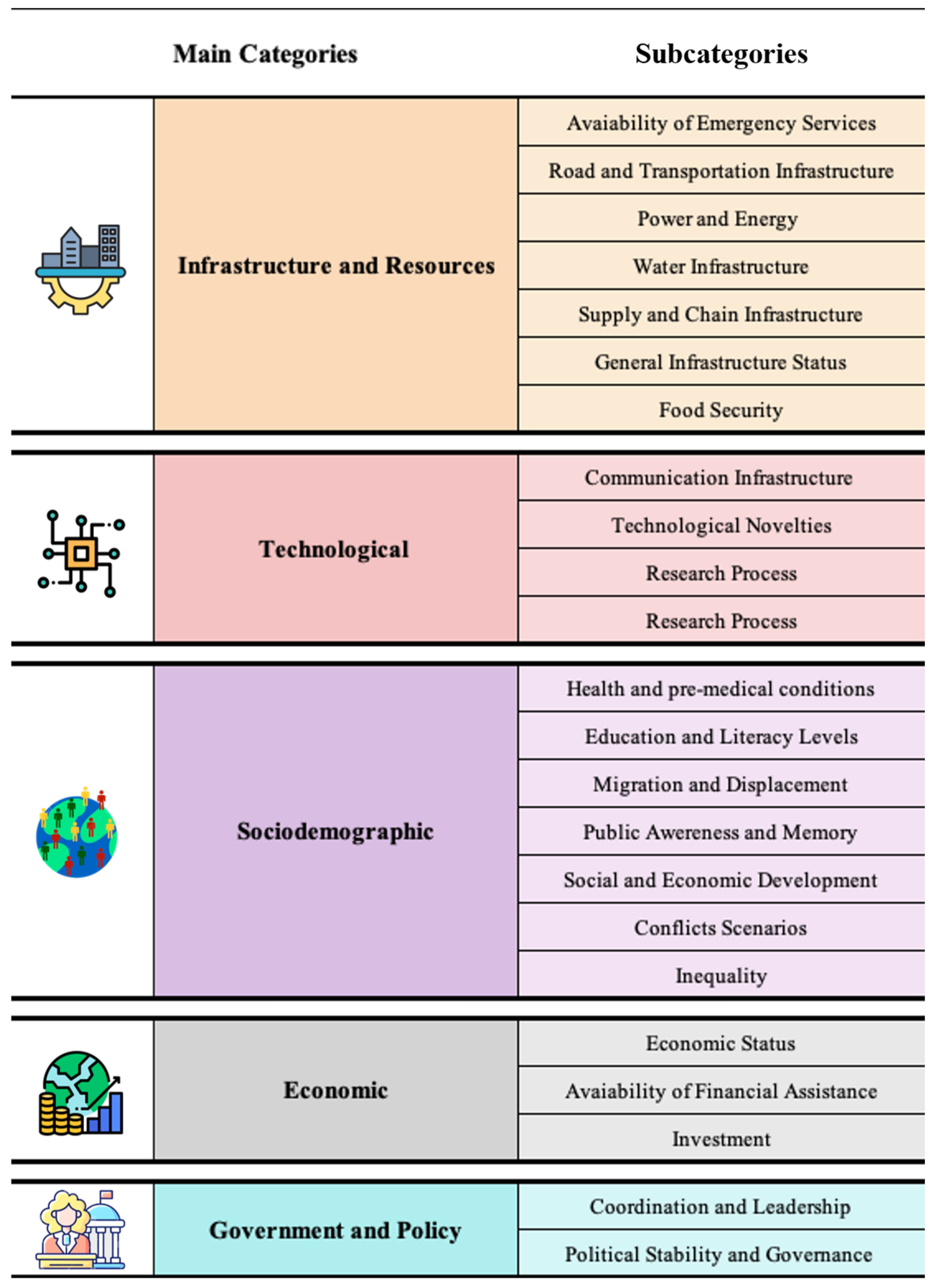
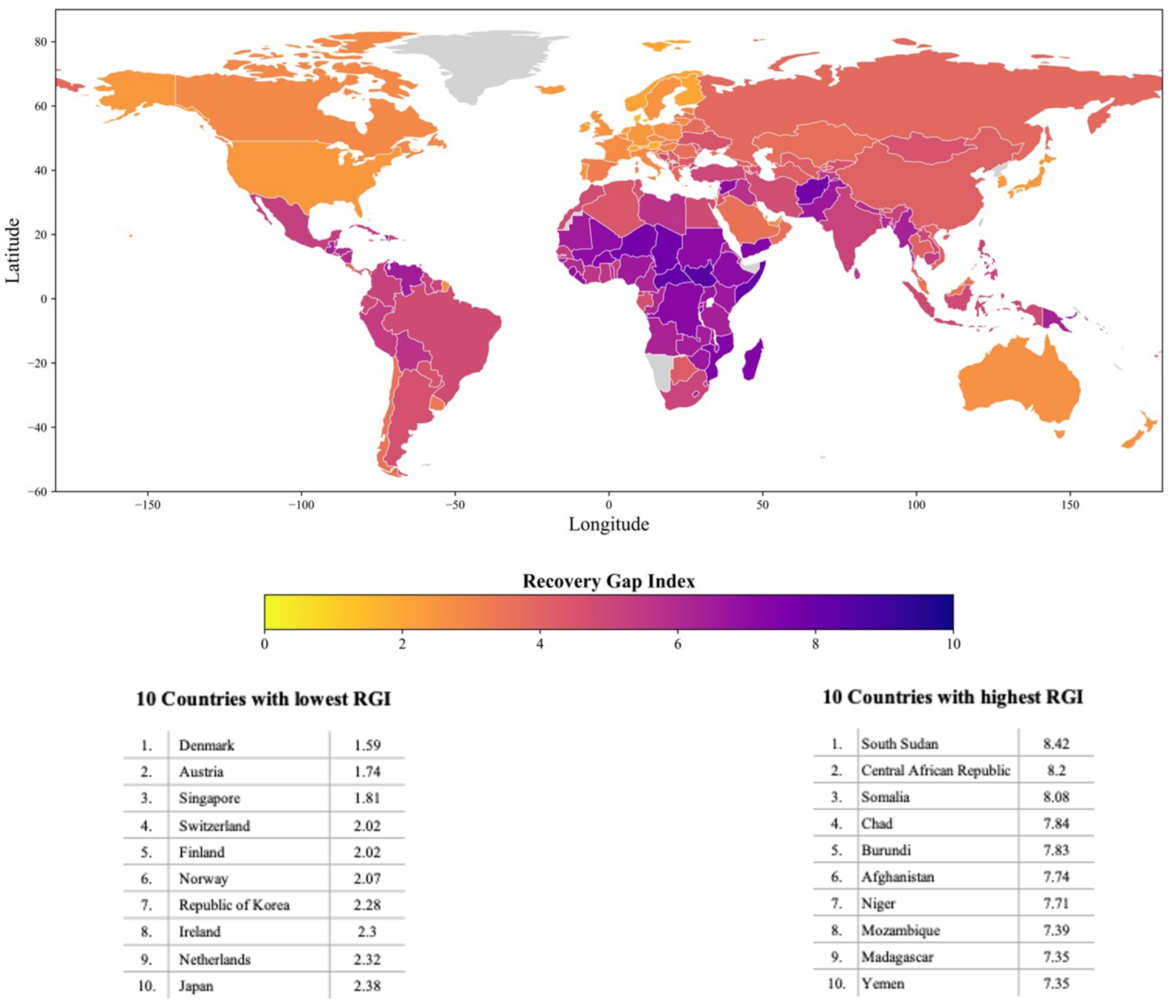
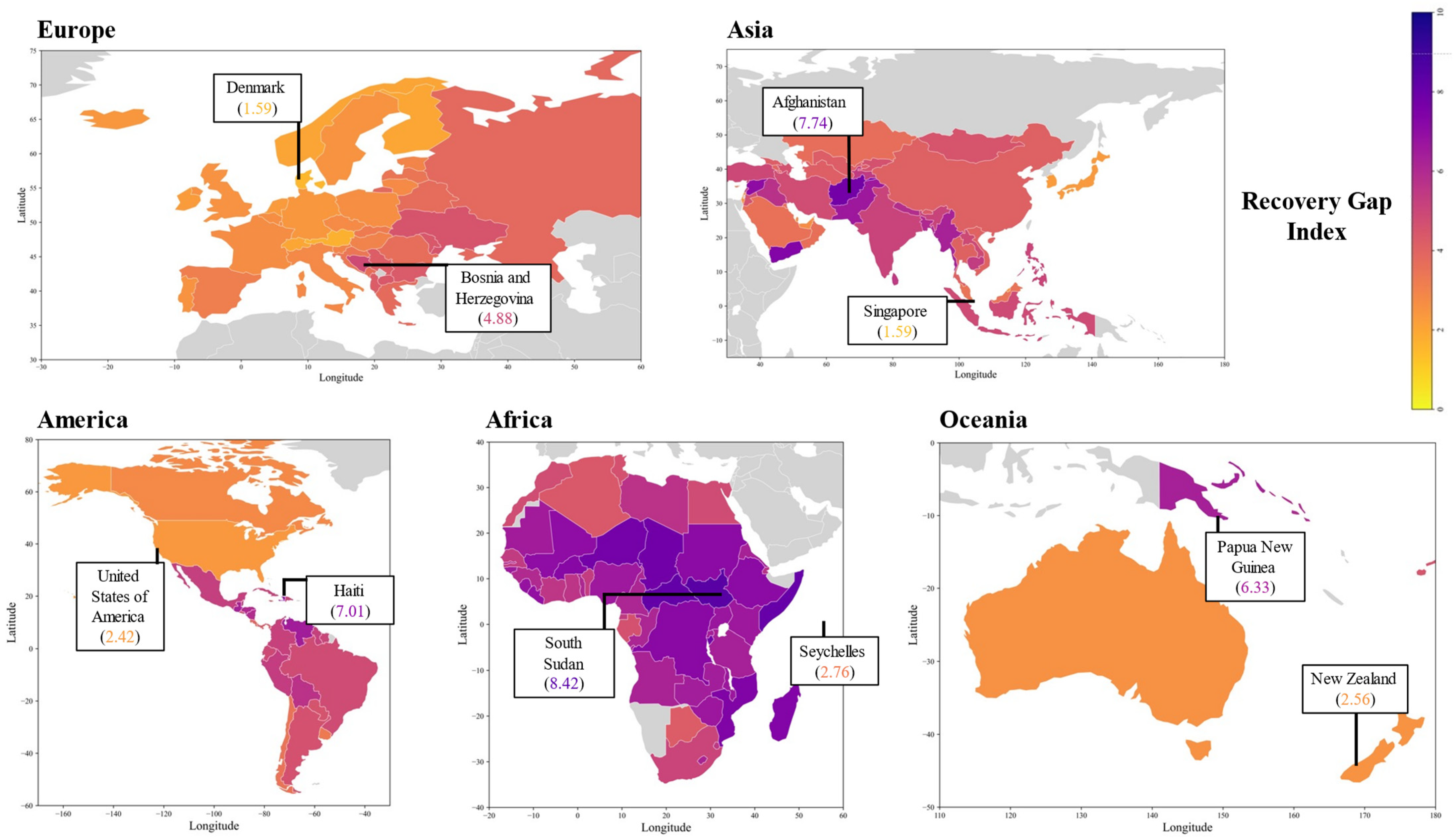
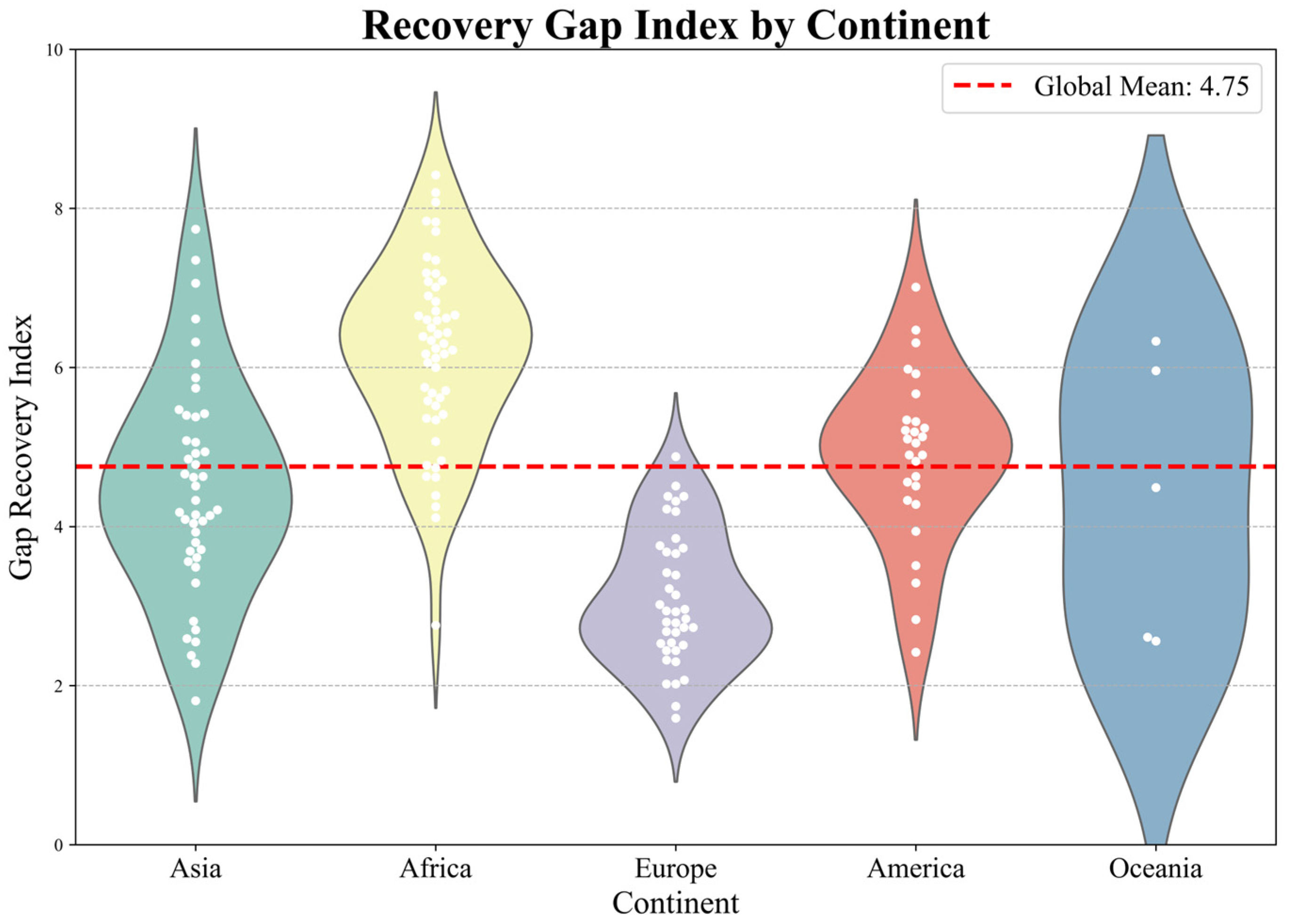

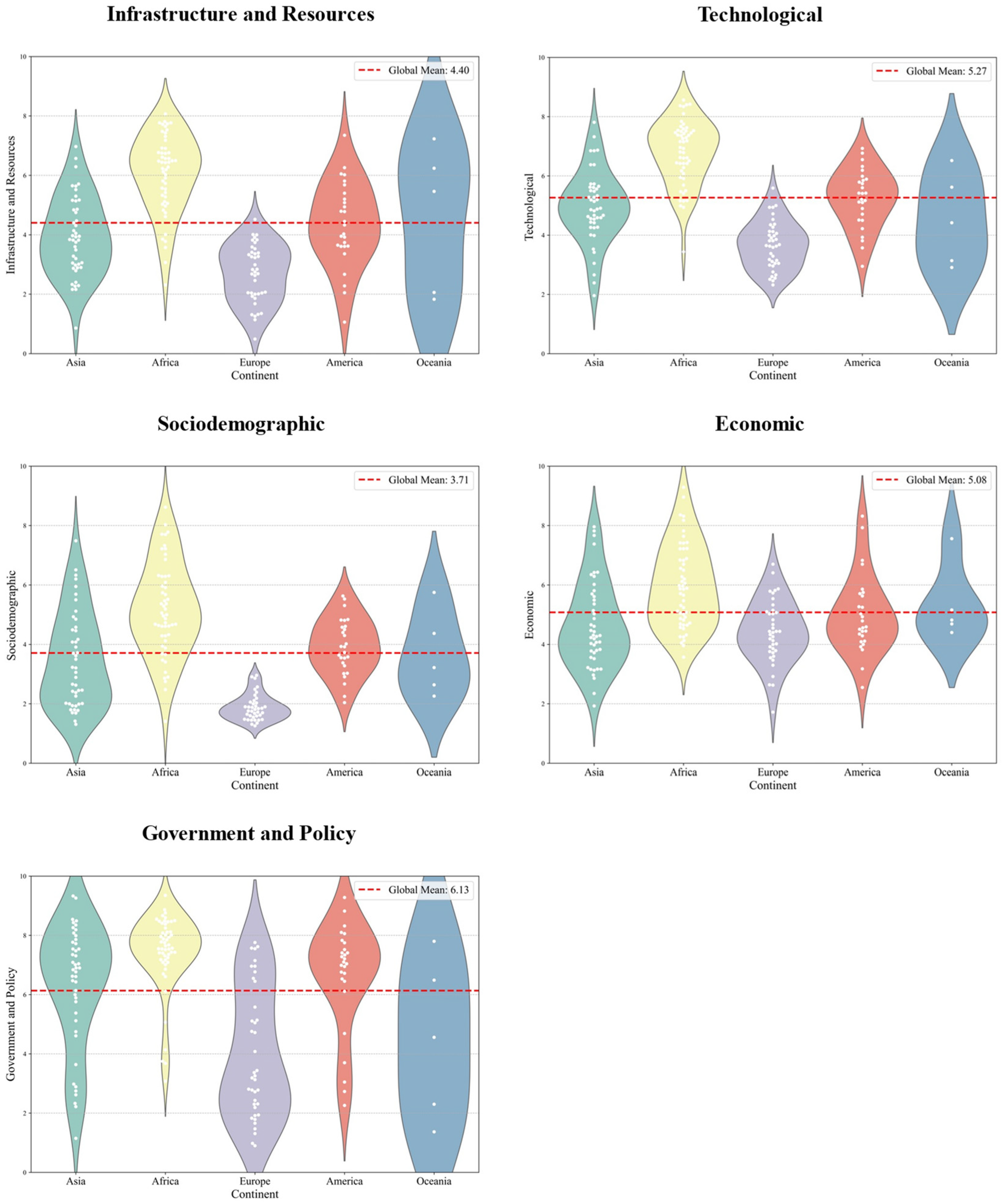
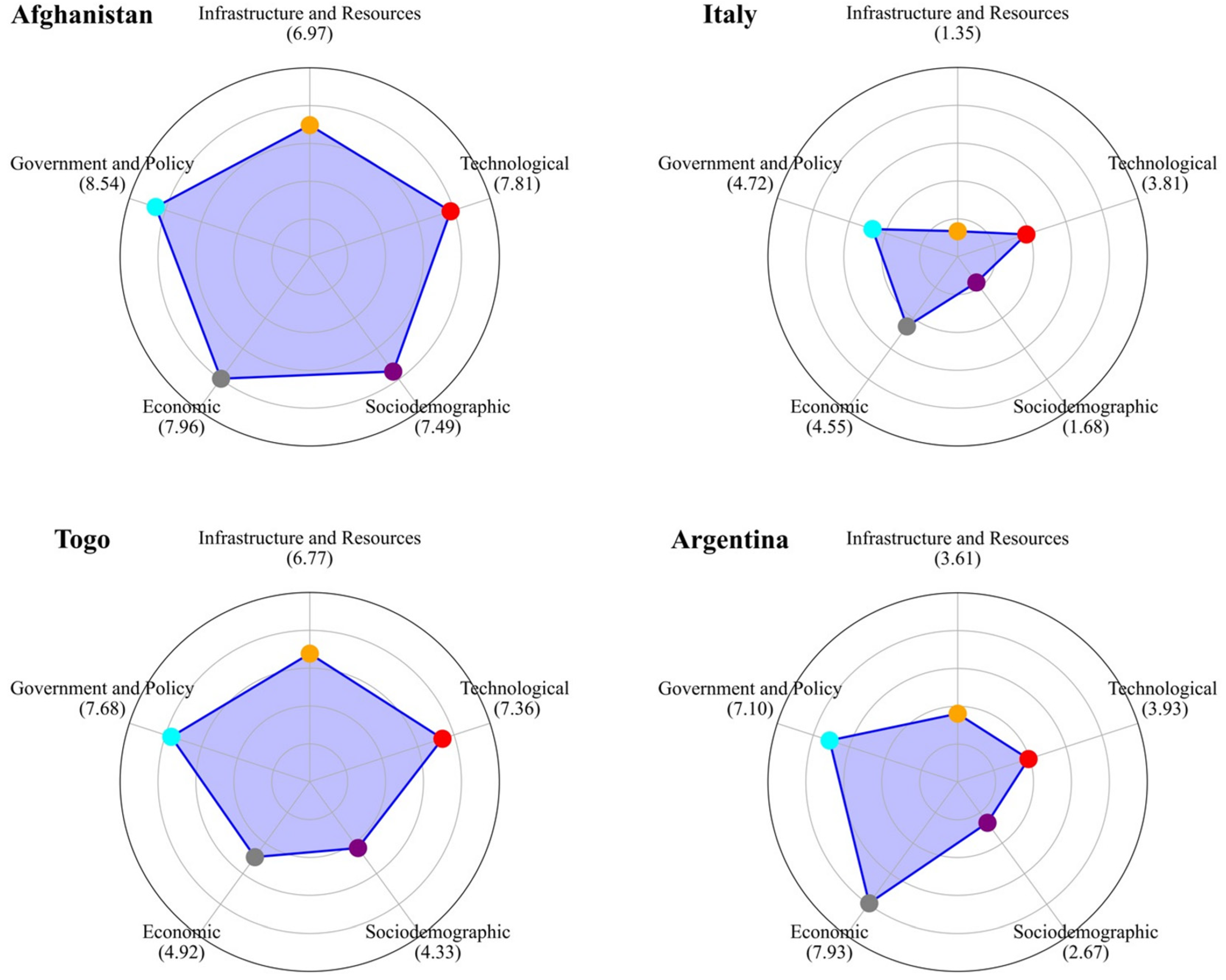
Disclaimer/Publisher’s Note: The statements, opinions and data contained in all publications are solely those of the individual author(s) and contributor(s) and not of MDPI and/or the editor(s). MDPI and/or the editor(s) disclaim responsibility for any injury to people or property resulting from any ideas, methods, instructions or products referred to in the content. |
© 2025 by the authors. Licensee MDPI, Basel, Switzerland. This article is an open access article distributed under the terms and conditions of the Creative Commons Attribution (CC BY) license (https://creativecommons.org/licenses/by/4.0/).
Share and Cite
Borre, A.; Ghizzoni, T.; Trasforini, E.; Ottonelli, D.; Rudari, R.; Ferraris, L. Developing the Recovery Gap Index: A Comprehensive Tool for Assessing National Disaster Recovery Capacities. Sustainability 2025, 17, 1044. https://doi.org/10.3390/su17031044
Borre A, Ghizzoni T, Trasforini E, Ottonelli D, Rudari R, Ferraris L. Developing the Recovery Gap Index: A Comprehensive Tool for Assessing National Disaster Recovery Capacities. Sustainability. 2025; 17(3):1044. https://doi.org/10.3390/su17031044
Chicago/Turabian StyleBorre, Alessandro, Tatiana Ghizzoni, Eva Trasforini, Daria Ottonelli, Roberto Rudari, and Luca Ferraris. 2025. "Developing the Recovery Gap Index: A Comprehensive Tool for Assessing National Disaster Recovery Capacities" Sustainability 17, no. 3: 1044. https://doi.org/10.3390/su17031044
APA StyleBorre, A., Ghizzoni, T., Trasforini, E., Ottonelli, D., Rudari, R., & Ferraris, L. (2025). Developing the Recovery Gap Index: A Comprehensive Tool for Assessing National Disaster Recovery Capacities. Sustainability, 17(3), 1044. https://doi.org/10.3390/su17031044





